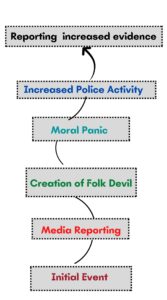Definition and Explanation
Amplification of deviance, also known as deviancy amplification (deviation amplification), is the concept that the media, by their reporting actions, contribute to the acceleration of behaviors of which most people disapprove. The procedure starts with a real-world occurrence or phenomenon, which is then covered by the media and given a headline. The majority of the populace becomes concerned due to the reporting and demands that action is taken due to their concerns. The response from the police is to allocate more resources to the area of concern, which ultimately results in arresting a more significant number of those participating in criminal behavior. When reporting on this new information, the media convey that the number of instances of the original action is growing faster than it really is. People who are more likely to engage in criminal conduct in the first place may also flock toward the locations where it is being reported, which might result in the phenomena occurring more often. A spiral is a helpful metaphor for illustrating how deviation may grow over time.
The concept of “deviancy amplification” proposes that the rise of criminal behavior in a society is an unintended result of several factors, including excessive policing, overreaction and labeling by the mainstream media, and the response of the general public to deviant stereotypes. The phrase “deviation amplification” was first used by Leslie T. Wilkins in his book Social Deviance published in 1967, where the word “deviation amplification” was first introduced. The theory is a significant component of the sociological critique of conventional criminology. Conventional criminology was reluctant to understand the context behind the idea of deviance and to understand crime as a social construct. The theory is an essential element within the sociological critique.
Amplification of deviance is a term that interactionist sociologists use to allude to how the levels of deviance or crime might be enhanced as a result of society’s response to the deviance itself. For instance, if there is a moral panic over anything, this serves as great advertising for moral panic.
Example 1 – UK 2011 Riots
For example, the unrest in the United Kingdom during the summer of 2011, which started in one neighborhood of London but swiftly extended over the whole city and subsequently to neighboring counties, began in one area of London. The reporting of the first deviance exacerbated it, which is why subsequent offenders were only aware of the riots via its broadcasting on 24-hour news broadcasts.
Example 2 – Mods and Rockers
This process was recognized in regard to mods and rockers by Stan Cohen’s research, Folk Devils and Moral Panics. The sensationalized reporting of fights between these youth subcultures produced a phenomenon and converted a few minor scuffles into a media event. During the 1950s and 1960s, two opposing youth subcultures existed in the United Kingdom: the mods and the rockers. A moral panic was stimulated concerning British youth due to media coverage of a confrontation between rockers and mods in 1964, and both subcultures were generally seen as aggressive, disruptive troublemakers.
Example 3 – White-Black issue in the US
For example, when there are drug and gun violence instances in African-American neighborhoods, the media tends to exaggerate the incident as a representation of the Afro-American community rather than displaying it as an individual case of deviance. The perception of the neighbors as being hostile, in turn, leads to an increase in the severity of the deviant behavior.
When, on the other hand, a white person shoots people in a mall in a white neighborhood, the incident is downplayed and represented as an individual incident. This prevents false information about the community from spreading through the media and into the minds of people who consume it.
Deviation amplification spiral
The sociologist Stanley Cohen believes that a deviant act is the first step in the spiral. In most cases, the deviation takes the form of illegal activity, but it may also encompass perfectly legal behavior that most people in a community find morally objectionable. As a result of the renewed emphasis on the problem, previously unnoticed or ambiguous incidents that, on their own, would not have been noteworthy are now being reported, confirming the trend. The exposure that has resulted from this has the potential to encourage further aberrant conduct by glorifying it, making it appear normal or acceptable, or all of the above.
According to proponents of the idea, the next step is when public worry over criminal activity often compels the police and the whole law enforcement system to expend more resources on dealing with the particular deviancy than is warranted by the situation. Judges and magistrates hand out more severe punishments when under pressure from the public. In response to the perceived risk, new laws are enacted by political actors. All of this has the effect of persuading the public that their fears were well-founded. At the same time, the media continues to benefit from reporting on activities involving the police and other law enforcement agencies.


